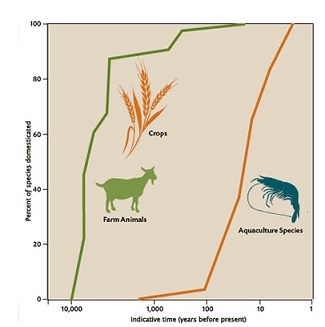Aquatic diversity makes vital contribution to global food security
Published: September 25, 2013
Source : FAO
Underwater and Unexplored
Aquaculture and capture fisheries production make vital contributions to global food security and provide important livelihood opportunities and income for many subsistence fishing and farming families. The world’s wealth of fish genetic resources provides great potential to enable the aquaculture and fisheries sector to further enhance its contribution to food security and meet future challenges in feeding a growing human population. Yet, despite estimates that an additional 40 million tonnes of fish per year will be required to meet global demand by 2030, the opportunities that fish genetic diversity has to offer remain largely unrealized and unexplored.
Capture fisheries: Maintaining aquatic biodiversity, including fish genetic diversity, in capture fisheries is fundamental to guaranteeing the productivity of fish stocks, their resilience and their adaptability to environmental change.
- Production of marine capture fisheries has increased to the extent that there is no room for further expansion, with more than 50 percent of the world’s marine fish stocks fully exploited, 17 percent overexploited and 8 percent depleted or recovering from overuse.
- Production of inland water fisheries is often affected by heavy fishing but, more importantly, by the effect of environmental degradation and modification of river basins, which affect fish production potential and biodiversity. The Millennium Ecosystem Assessment found some 20 percent of the world’s freshwater fish species have been listed as threatened, endangered or extinct, in just the last few decades.
Aquaculture: The contribution of aquaculture to world food fish production soared from 3.9 percent in 1970 to about 48 percent in 2006, with growth expected to continue. Aquatic genetic resources are of pivotal importance for the further genetic improvement of fish strains, to achieve sustainable development of aquaculture.
Aquatic ecosystems: Rising temperatures associated with climate change are threatening low-lying coastal areas of both island and mainland nations, affecting species distribution and creating conditions that are conducive to the introduction and spread of invasive alien species and the resulting loss of aquatic biodiversity, which will have potentially negative impacts on the type and size of catches.

Aquatic genetic diversity
The need for conservation and responsible use
The need for conservation and responsible use
Collection of fish genetic resources has taken on a sense of urgency that reflects the pressures on the earth’s aquatic ecosystems and habitats. The process of conserving fish genetic resources is challenging, complicated and often expensive. Efforts are increasing, but gene banking of fish genetic resources is still at an early stage.
There are many potential strategies for the sustainable management of aquatic genetic resources. The FAO Code of Conduct for Responsible Fisheries promotes the conservation of aquatic genetic diversity, maintaining the integrity of aquatic communities and ecosystems, and responsible use of living aquatic resources at all levels, including the genetic level. Ecosystem approaches to the development of responsible aquaculture and capture fisheries also emphasize management of fish genetic resources. FAO has a long tradition of using an ecosystem approach in fisheries and, in 2007, published Technical Guidelines on Genetic Resource Management to support the Code of Conduct for Responsible Fisheries.
The Commission on Genetic Resources for Food and Agriculture.
Taking steps to identify and sustain aquatic genetic resources
Taking steps to identify and sustain aquatic genetic resources
The Commission on Genetic Resources for Food and Agriculture considered the issue of managing aquatic genetic diversity for the first time in 2007, calling upon its Members to initiate steps to determine the current state of the world’s aquatic genetic resources. Initial results have found that valuable information that has the potential to contribute to improved management of fish genetic resources is scattered, kept in diverse assortment of incompatible formats, neither readily accessible nor archived in a secured manner.
Recognizing the urgency of the situation, and as a first step toward compiling the first State of the World’s Aquatic Genetic Resources for 2013, the Commission has launched a review of existing information systems, and will work to develop a more streamlined reporting system for national and international organizations. With the number of farmed fish strains, hybrids and other genetic resources increasing in aquaculture, information systems are needed to identify and determine their relative contributions to farmed fish production. Similarly, better information on the genetics of wild fish populations should contribute to better understanding the needs for conservation and sustainable use.
In addition, the Commission will identify and develop cooperative action and partnerships, which together with an enabling policy environment, will support the maintenance and conservation of a broad genetic base in aquaculture and capture fisheries. This will include working in cooperation with FAO’s Committee on Fisheries to expand upon the elements of the Code of Conduct for Responsible Fisheries that target the conservation and sustainable use of aquatic genetic resources.
Source
FAORecommend
Comment
Share
Freshwater Solutions- Ecological aquaculture
25 de septiembre de 2013
Aquatic diversity makes vital contribution to global food security ? Yes it does, where it still exists, which is in fewer and fewer places. Until very large no take fish zones are created, populations that rely on fishing just to sustain life will die. Ocean fishing licences are up for grabs to the highest bidder, local native populations are not being considered. As fish becomes scarcer and prices rise these subsistence fisherman will and are disappearing.
A free and ever declining ocean resource becomes more expensive more powers will be needed to protect this vital resource.
Even in the western world records of inland capture fisheries do not exist and have never really done so, expecting such data in the developing world is but a dream.
Recommend
Reply

Would you like to discuss another topic? Create a new post to engage with experts in the community.





